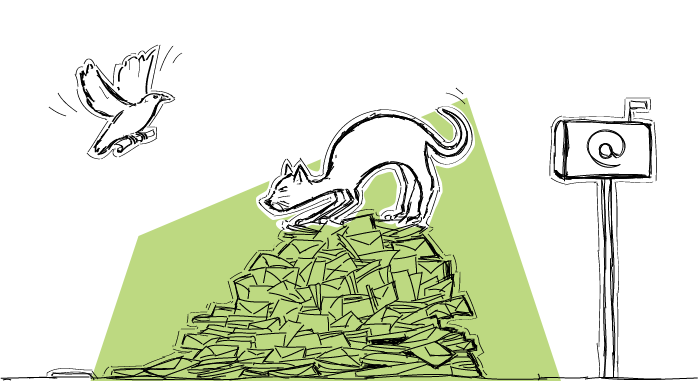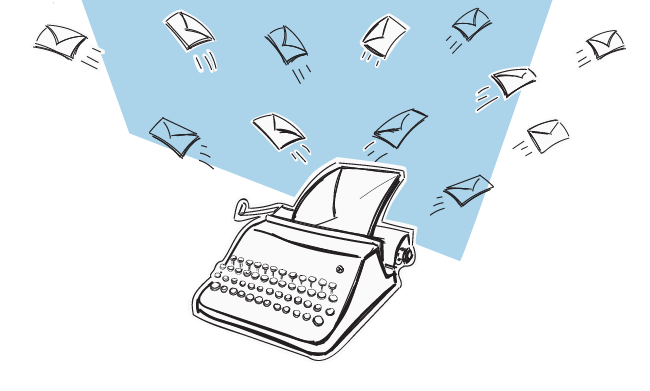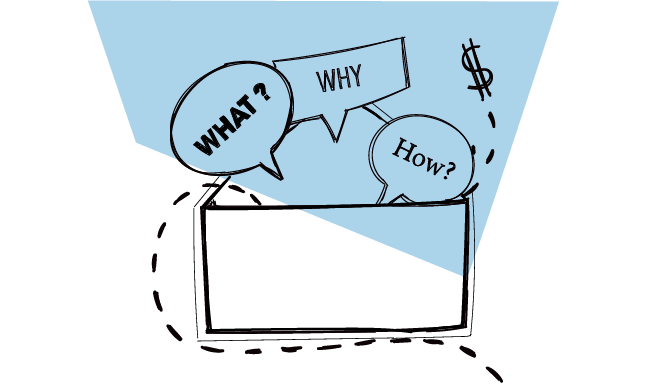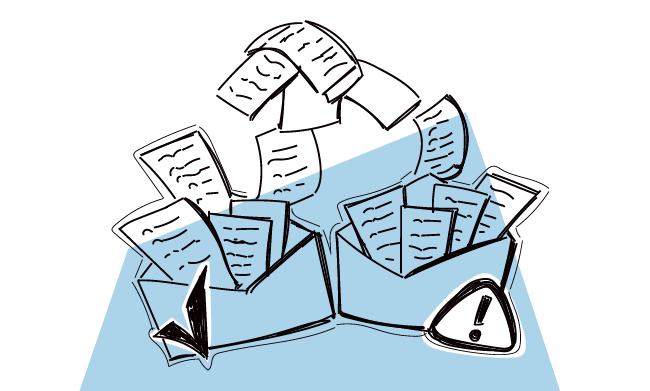You created a highly targeted prospect list and carefully scheduled the campaign. Everything went smoothly from the technical side, yet you received just a few positive replies. What went wrong, then?
The problem may be in the message itself.
Read on to learn what are the dos and don’ts for writing cold emails. Check what you can change in your cold email copy and subject line to get more positive replies.
Avoid vague subject lines
Even though we shouldn’t judge the book by its cover, sometimes we can’t help it. Have you ever picked a bottle of wine just because the label caught your attention? Or opened a blog post because the title sparked your interest?
Here I got you.
Think of an email subject line as the packaging of your message. It makes your prospects decide whether they open your email, ignore it or delete immediately without even checking what’s inside.
When I open my mailbox I often see subject lines like “Question” or “Woodpecker <> Unknown Company Name” that don’t tell me much about what to expect when I open the message. They are too vague to spark my interest. And they repeat in almost every second email in my inbox.
Put yourself in your prospect‘s shoes for a moment. Why would they care about a “Question” from a stranger? Especially if they get dozens of emails with exactly the same subject line per week that fight for their attention. In such a flood of look-alikes, only a subject line that stands out by being relevant and promising will win.
So what subject line would encourage a prospect who doesn’t know your company to open a message from you?
For example, the one that refers to a business need they have or a problem they currently struggle with. Something that will make them think “Hmm this sounds interesting. I’ll check it out, maybe that’s something I could benefit from”. Or something along these lines. You get the idea.
Check the best subject lines we’ve come across and find out why they work so well:
15 Best Sales Email Subject Lines We’ve Come Across >>
Always end your email with a clear Call to Action
If you think about a subject line as a key to get your emails opened, a CTA is a key to encourage people to reply. A CTA should be the answer to a crucial question our addressee will be asking themselves, that is: “What do they want from me?”
This answer should be conveyed in one of your email’s last sentences, so it makes the goal of your message clear. It should be specific and persuasive, so it leaves no doubt about what you’re asking your addresses to do, be it answering a question, meeting in person, having a call or leaving a review.
Take a look at your CTA now. Is it clear and specific? Would you know what to do if you were a prospect? Aren’t you asking them for too much? Keep in mind that you’re still just a stranger to them and asking for a 30-minute chat or a meeting in person may be too much at this point.
Check how a CTA may be worded to match various intents and persuade the addressees to take action: Perfect CTA, or How to Write a Persuasive Cold Email? >>
Don’t make people read essays, be clear and concise
Imagine this: your message caught your prospect’s attention thanks to a relevant and prospect-oriented subject line. Intrigued by it, they open the email and… bump into a wall of text that scares them away.
A big block of text is hard to read. It makes your message look boring and off-putting. Very few prospects will wade through it till the end to read a CTA.
That’s why you should try to squeeze your message into just a few sentences. Cross out all the unnecessary sentences that only drive your prospects’ attention away from the goal of your message. Be merciless to all the fluff surrounding your point. Less is more in this case.
Don’t paste a URL, add a hyperlink instead
Every time I see a long spaghetti-like URL pasted into the email copy I wonder… why? Not only does it look ugly and make the sender look lazy, but also it’s based on a naive assumption that an addressee will do the extra work of copy-pasting it into their search box. Voluntarily. Despite being busy with other usually more important things they have to do. I’m sorry, but It just won’t happen.
When you want to direct a prospect to your website, always add a clickable hyperlink. And don’t just turn a URL into a hyperlink like this: https://woodpecker.co/. Give it some shape. Hide it under some words, like I just did here: check our website.
And remember to always double-check if a link works — broken links harm your credibility and make a bad first impression.
Double-check the spelling and grammar
How would you prepare for a face-to-face meeting with a potential business partner? I suppose you’d take good care of how you look and how you’re dressed because we all know that there’s only one chance to make a good first impression.
In cold emailing, your message makes the first impression on a potential customer or business partner who doesn’t know you yet. Grammar mistakes, typos, or bad spelling make a message look sloppy. That bad image transfers to you and your company.
I realize that not everybody is a grammar hero and that’s totally fine because we have modern technology to do a grammar and spelling check for us, for example, Grammarly. Add it to your browser and it will do the check as you write.
Also, go through your message one last time before you hit send. Be on the lookout of unfinished or messy sentences and possible gaps in logic. It will only take a minute or two of your time but you’ll avoid risking your professional image.
Speak the language of benefits, don’t focus on product’s features
Have a look at this example:
“Woodpecker is a tool for sending automated cold emails and follow-ups. It’s sending mechanism is based on a special email throttling algorithm. You can personalize each message with mail merge fields, called snippets.“
And now compare it with this one:
“Scale your lead generation process and start more B2B relationships without the need to scale your team. Send cold email and follow-up sequences that will be sent automatically but also one by one, as if you sent them by hand. By using mail merge fields called snippets you can tailor your messages to each prospect from your list to make them feel unique and personal even at scale.”
See the difference? First fragment is product-oriented. It simply lists the product’s features. Boring. How can I know what’s in it for me? Second passage gives me a better picture of what I can actually do with Woodpecker and what advantage it gives me.
Your prospects don’t care much about what awesome features your product has. What they want to know most is what’s in it for them. How their business can benefit from it.
That’s why it’s crucial to get to know your prospect first, learn about their needs and challenges and use this knowledge to put forward arguments that will resonate with them best.
Read How to Present Your Product in a Cold Email? >>
Don’t copy-paste “best cold email templates”
Some cold email templates seem perfect. You may think “Whoa, I would never come up with anything better than that.” You would, trust me. Nevertheless, copying and pasting “the best cold email template” is a bad idea for two reasons:
- there’s a high chance that your prospect has already received the same email from someone else, so your copy-paste trick will eventually come out;
- SPAM filters are sensitive to repeatable patterns, so your email may end up in a SPAM folder.
So avoid the temptation to copy&paste and try to tailor your message to your prospects instead. It’ll require some extra effort and a bit more time than copying a ready-made template, but it will pay off. If a prospect gets a message that stands out from all the other ones they received you’ll get their attention.
So ensure they can relate to what you wrote. Speak the language of benefits as I already mentioned. And use advanced personalization to differentiate the content a little, so it doesn’t alarm SPAM filters.
Don’t try too hard to sell, focus on building relationships
Hard selling is plaguing cold emails. I’ve seen many messages that focus on the pitch instead of a prospect’s business, their needs or challenges they face. Cold email has never meant to close a sale. It’s always been here for building connections between businesses. That’s why you shouldn’t put anything that resembles an offer in your message.
Avoid phrases like:
- I think my offer may interest you
- Check out the details of my offer
- I have a great solution just for your
- I can offer you a special discount
Leave selling for later, first build rapport with your prospects. Learn more about their business needs. Then, show them how their process can be improved or how their problem will disappear when they use your tool or service. Give them this before-and-after contrast that will hook them.
Don’t use SPAM trigger words
Or at least try to avoid them as much as you can. Find a synonym or rephrase the sentence, if you can. Check which words better not to use in cold email copy here. Also, be careful with numbers and signs like % or $.
In some industries, like finance and real estate, it may be trickier than in others, though. That’s because much of vocabulary specific to these niches is listed on SPAM lists. To overcome this pain:
- don’t go into details of your offer in the opening email, focus more on developing a dialog,
- leave talking about money and discounts for follow-ups or replies (spam words in follow-ups and replies don’t alert spam filters as much, because they are sent in the same thread as the opening email)
- send small campaigns, so the chances to alert spam filters are lower.
Here’s a full post on how to overcome a pain of cold emailing in finance and real estate >>
Avoid email clichés
What’s a cold email cliché? It can be the whole template or just a phrase, which has been so overused that it makes prospects roll their eyes every time they come across it again. As you can guess, such hackneyed patterns do more bad than good: you come out as just one of the crowd plus your deliverability may suffer too.
Some clichés tend to be “evergreen” so to speak, and others are just kind of a trend for a while and then disappear. Check one of the most recent cliché examples I’ve come across:
“I am writing in hopes of finding the appropriate person who handles <XYZ>?”
Get rid of clichés in your cold email copy and see how your reply rate improves.
Read more about Cold Email Clichés, or What Your Prospects Have Seen Too Many Times to Care >>
Practice to write cold emails that convert
Writing a cold email that resonates well with the prospects isn’t an easy task. It requires some practice. I hope these tips will help you spot any possible weak points in your cold email copy and write killer messages in the future.
What is the trickiest part of writing a cold email for you? Let me know!
READ ALSO

10 Reasons Why Your Cold Emails Are Getting No Response
This week we have a guest post by Nina Cvijovic, who is a researcher and writer at Etools. Nina analyzed 10 reasons why your outbound email campaigns may not be reaching the response rate you expect them to, or are not generating any responses at all. Either way, there's always a field for improvement in cold emailing. So go through the 10 checkpoints below, and read some advice on how your response rates can be improved.

10 Tips to Write a Cold Sales Email From a Copywriter
Cold email copy can make or break your email campaign. A perfectly targeted prospect base won’t guarantee success if your message doesn’t catch their interest. Unfortunately, many cold emails fail to do that. The most common problems with cold email copy that I've come across are the lack of clarity, impersonality, unnecessary wordiness and egocentrism. These things make prospects delete the message without even reading it till the end. In this blog post, I want to share with you some copywriting tips that will help you write more prospect-oriented, valuable and engaging sales emails that will get opened, read and replied to.

A Guide to Asking Open-Ended Questions in Sales Emails
What is the goal of a sales email? To close a deal? Yes, eventually. But first and foremost to gain your prospect’s trust and build a fruitful, long-lasting business relationship. In real life, creating rapport between two strangers starts with a meaningful conversation. And the spark for dialogue is usually a spot-on and engaging question. It’s no different in outbound sales. Asking high-value questions in sales emails is a skill to master. Let’s take a closer look at how to do it.

